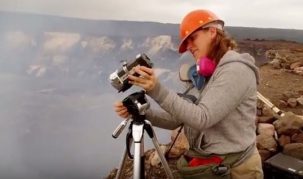volcanoes4
-

Peering into Volcanoes: a Talk with Einat Lev
What do the scientists and researchers around the Earth Institute do? In this second in a series, Einat Lev from the Lamont-Doherty Earth Observatory talks about her work on volcanoes what she’d like people to know about it, and what inspired her to go into the field.
-

Walking in the Shadow of a Great Volcano
On a ledge just inside the lip of Chile’s Quizapu volcanic crater, Philipp Ruprecht was furiously digging a trench. Here at an elevation of 10,000 feet, a 1,000-foot plunge loomed just yards away, and wind was whipping dust off his shovel. But the volcanologist was excited. Ruprecht had just found this spot, topped with undisturbed…
-

Photo Essay: In the Shadow of a Great Volcano
High in the southern Andes, Chile’s Quizapu crater is one of South America’s most fearsome geologic features. In 1846, it was the source of one the continent’s largest historically recorded lava flows. In 1932, it produced one of the largest recorded volcanic blasts. The volcano is currently inactive, but could revive at any time. What…
-

Weber, Plank Elected to American Academy of Arts and Science
Elke Weber, who studies how people make decisions and how they think about climate change, and Terry Plank, who probes deep into the Earth’s interior to study magma and how volcanoes erupt, are among the members elected to the American Academy of Arts and Science this year.
-

‘Popping Rocks’ and Robots
It turns out that studying lava flows at the bottom of the ocean uses many of the same methods as studying lava flows on other planets, writes Lamont’s Elise Rumpf.
-

Peering into Chile’s Quizapu Volcano
In their quest to unravel the physical and chemical processes controlling volcanic eruptions, Einat Lev and colleagues headed to South America and the volcanoes of Chile.
-

Testing the Speed of Lava: What It Says about Escape Times & Mars
Elise Rumpf’s lava flow simulations are yielding new details about the velocity of lava over different surfaces. They may also hold clues about the surfaces of other planets.

AGU25, the premier Earth and space science conference, takes place December 15-19, 2025 in New Orleans, Louisiana. This year’s theme—Where Science Connects Us—puts in focus how science depends on connection, from the lab to the field to the ballot box. Once again, Lamont-Doherty Earth Observatory and Columbia Climate School scientists, experts, students, and educators are playing an active role, sharing our research and helping shape the future of our planet. #AGU25 Learn More


